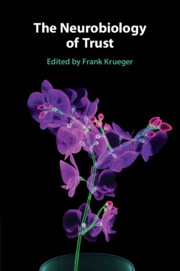Book contents
- The Neurobiology of Trust
- The Neurobiology of Trust
- Copyright page
- Dedication
- Contents
- Figures
- Tables
- Contributors
- Abbreviations
- Introduction
- Part I Fundamental Level of Trust
- Part II Neuropsychological Level of Trust
- Part III Neurocharacteristic Level of Trust
- Chapter 9 Trust and Distrust
- Chapter 10 Trust and Reciprocity
- Chapter 11 Trust and Demographics
- Chapter 12 Trust and Brain Dynamics
- Part IV Neuromolecular Level of Trust
- Part V Neuropathological Level of Trust
- Index
- References
Chapter 11 - Trust and Demographics
Age and Gender Differences in Trust and Reciprocity Behavior
from Part III - Neurocharacteristic Level of Trust
Published online by Cambridge University Press: 09 December 2021
- The Neurobiology of Trust
- The Neurobiology of Trust
- Copyright page
- Dedication
- Contents
- Figures
- Tables
- Contributors
- Abbreviations
- Introduction
- Part I Fundamental Level of Trust
- Part II Neuropsychological Level of Trust
- Part III Neurocharacteristic Level of Trust
- Chapter 9 Trust and Distrust
- Chapter 10 Trust and Reciprocity
- Chapter 11 Trust and Demographics
- Chapter 12 Trust and Brain Dynamics
- Part IV Neuromolecular Level of Trust
- Part V Neuropathological Level of Trust
- Index
- References
Summary
Trust is present from a very young age, but its expression in social interactions shows important changes over the lifetime. This chapter summarizes the research on age differences in trust, and explores the differences between males and females. Trust behavior can be measured using the trust game, which simulates a social interaction. Research shows that at a young age, trust is present at the start of the interaction but it is yet unclear whether this increases throughout development. Studies indicated an increase in the ability to adapt trust behavior, as well as an increase of reciprocity behavior throughout adolescence. Relatedly, an increase of activity in mentalizing-related areas and a decrease of activity in areas related to reward and conflict monitoring during adolescence and young adulthood is found. Often, males show more trust behavior than females although these differences are small. Sex differences in reciprocity behavior are found less often. Neuroimaging studies showed males have more activity in mentalizing-related areas while females show more activity in areas associated with reward and learning processes. Future studies may examine individual differences in the neural mechanisms of trust in relation with social context factors, such as cultural orientation or socioeconomic status.
- Type
- Chapter
- Information
- The Neurobiology of Trust , pp. 269 - 292Publisher: Cambridge University PressPrint publication year: 2021



